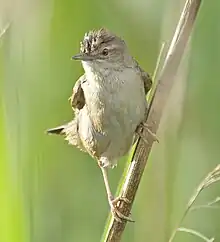Grass warbler
The grass warblers are small passerine birds belonging to the genus Locustella. Formerly placed in the paraphyletic "Old World warbler" assemblage, they are now considered the northernmost representatives of a largely Gondwanan family, the Locustellidae.
| Grasshopper warblers | |
|---|---|
 | |
| Savi's warbler (Locustella luscinioides) | |
| Scientific classification | |
| Domain: | Eukaryota |
| Kingdom: | Animalia |
| Phylum: | Chordata |
| Clade: | Dinosauria |
| Class: | Aves |
| Order: | Passeriformes |
| Family: | Locustellidae |
| Genus: | Locustella Kaup, 1829 |
| Type species | |
| Sylvia locustella[1] Latham, 1790 | |
| Species | |
|
see text | |
These are rather drab brownish "warblers" usually associated with fairly open grassland, shrubs or marshes. Some are streaked, others plain, all are difficult to view. They are insectivorous.
The most characteristic feature of this group is that the song of several species is a mechanical insect-like reeling which gives rise to the group's scientific name.
Species breeding in temperate regions are strongly migratory.
Taxonomy
The genus Locustella was introduced by the German naturalist Johann Jakob Kaup in 1829 with the common grasshopper warbler (Locustella naevia) as the type species.[2][3] The genus name Locustella is from Latin and is a diminutive of locusta, "grasshopper".[4] Like the English name, this refers to the insect-like song of some species.[5]
There are 23 species placed in the genus:[6]
- Lanceolated warbler, Locustella lanceolata
- Brown bush warbler, Locustella luteoventris
- Long-billed bush warbler, Locustella major
- Common grasshopper warbler, Locustella naevia
- Chinese bush warbler, Locustella tacsanowskia
- Bamboo warbler, Locustella alfredi
- River warbler Locustella fluviatilis
- Savi's warbler, Locustella luscinioides
- Friendly bush warbler, Locustella accentor
- Sulawesi bush warbler, Locustella castanea
- Seram bush warbler, Locustella musculus
- Buru bush warbler, Locustella disturbans
- Long-tailed bush warbler, Locustella caudata
- Baikal bush warbler, Locustella davidi
- Spotted bush warbler, Locustella thoracica
- West Himalayan bush warbler, Locustella kashmirensis
- Taiwan bush warbler, Locustella alishanensis
- Russet bush warbler, Locustella mandelli
- Dalat bush warbler, Locustella idonea
- Benguet bush warbler, Locustella seebohmi
- Javan bush warbler, Locustella montis
- Sichuan bush warbler, Locustella chengi
- Taliabu bush warbler, Locustella portenta
This genus formerly included additional species. A molecular phylogenetic study of the grassbird family Locustellidae published in 2018 found that the genus Locustella consisted of two distinct clades. The genus was split and six species were moved to the newly erected genus Helopsaltes.[7][6]
A fossil acrocoracoid from the Late Miocene (about 11 mya) of Rudabánya (NE Hungary) is quite similar to this bone in the present genus.[8] Given its rather early age (most Passerida genera are not known until the Pliocene), it is not too certain that it is correctly placed here, but it is highly likely to belong to the Locustellidae, or the Sylvioidea at the least. As the grasshopper warblers are the only known locustellid warblers from Europe, it is still fairly likely that the bone piece belongs to a basal Locustella.
References
- "Locustellidae". aviansystematics.org. The Trust for Avian Systematics. Retrieved 2023-07-15.
- Kaup, Johann Jakob (1829). Skizzirte Entwickelungs-Geschichte und Naturliches System der Europaischen Thierwelt (in German). Vol. 1. Darmstadt: Carl Wilhelm Leske. p. 115.
- Mayr, Ernst; Cottrell, G. William, eds. (1986). Check-list of Birds of the World. Vol. 11. Cambridge, Massachusetts: Museum of Comparative Zoology. p. 50.
- Jobling, James A (2010). The Helm Dictionary of Scientific Bird Names. London: Christopher Helm. p. 229. ISBN 978-1-4081-2501-4.
- "Grasshopper". Oxford English Dictionary (Online ed.). Oxford University Press. (Subscription or participating institution membership required.)
- Gill, Frank; Donsker, David, eds. (2019). "Grassbirds, Donacobius, Malagasy warblers, cisticolas, allies". IOC World Bird List Version 9.2. International Ornithologists' Union. Retrieved 27 August 2019.
- Alström, P.; Cibois, A.; Irestedt, M.; Zuccon, D.; Gelang, M.; Fjeldså, J.; Andersen, M.J.; Moyle, R.G.; Pasquet, E.; Olsson, U. (2018). "Comprehensive molecular phylogeny of the grassbirds and allies (Locustellidae) reveals extensive non-monophyly of traditional genera, and a proposal for a new classification". Molecular Phylogenetics and Evolution. 127: 367–375. doi:10.1016/j.ympev.2018.03.029. PMID 29625229.
- Bernor, R.L.; Kordos, L. & Rook, L. (eds):"Recent Advances on Multidisciplinary Research at Rudabánya, Late Miocene (MN9), Hungary: A compendium Archived 2007-06-28 at the Wayback Machine". Paleontographica Italiana 89: 3-36.